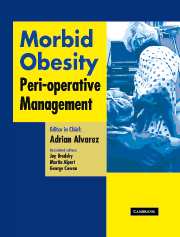Book contents
- Frontmatter
- Contents
- Contributors
- Foreword
- Preface
- Acknowledgments
- Dedication
- Section 1 General aspects
- Section 2 Pathophysiology
- 4 Lung physiology
- 5 Cardiac morphology and ventricular function
- 6 Pathophysiology of cardiovascular co-morbidities
- 7 Physiological changes during laparoscopy
- 8 Digestive physiology and gastric aspiration
- Section 3 Pre-operative management
- Section 4 Peri-operative management of co-morbidities
- Section 5 Pharmacology
- Section 6 Monitoring
- Section 7 Intra-operative management
- Section 8 Post-operative care
- Section 9 Conclusions
- Afterword
- Index
6 - Pathophysiology of cardiovascular co-morbidities
from Section 2 - Pathophysiology
Published online by Cambridge University Press: 17 August 2009
- Frontmatter
- Contents
- Contributors
- Foreword
- Preface
- Acknowledgments
- Dedication
- Section 1 General aspects
- Section 2 Pathophysiology
- 4 Lung physiology
- 5 Cardiac morphology and ventricular function
- 6 Pathophysiology of cardiovascular co-morbidities
- 7 Physiological changes during laparoscopy
- 8 Digestive physiology and gastric aspiration
- Section 3 Pre-operative management
- Section 4 Peri-operative management of co-morbidities
- Section 5 Pharmacology
- Section 6 Monitoring
- Section 7 Intra-operative management
- Section 8 Post-operative care
- Section 9 Conclusions
- Afterword
- Index
Summary
Introduction
The peri-operative care of a morbidly obese patient requires a knowledge of the pathophysiology of morbid obesity that might contribute to a problematic outcome. The concerns, like those for most patients exposed to anesthesia are: airway, respiratory, gastrointestinal, endocrine, and cardiovascular. The assessment of each of these areas is essential for the safe care of the patient. This chapter is devoted to a consideration of the cardiovascular physiology and pathology of the morbidly obese patient.
The prevalence of obesity is increasing worldwide. Over 65% of the adult population in the US is reported to be overweight (body mass index, BMI > 25kg/m2) and 31% are characterized as obese (BMI > 30 kg/m2). The incidence of type 2 diabetes, a disease closely linked to obesity, has increased 10-fold between 1982 and 1994.
The Framingham Heart Study examined the development of cardiovascular complications over a 44-year follow-up as a function of (BMI, weight in kilograms divided by the square of height in meters). The study population was divided into three groups: normal (BMI 18.5–24.9), overweight (BMI 25.0–29.9), and obese (BMI ≥ 30) individuals. 5209 subjects were enrolled in the Framingham Study between 1948–1951, they ranged in age at the time of enrollment from 30 to 62 years.
- Type
- Chapter
- Information
- Morbid ObesityPeri-Operative Management, pp. 69 - 80Publisher: Cambridge University PressPrint publication year: 2004



